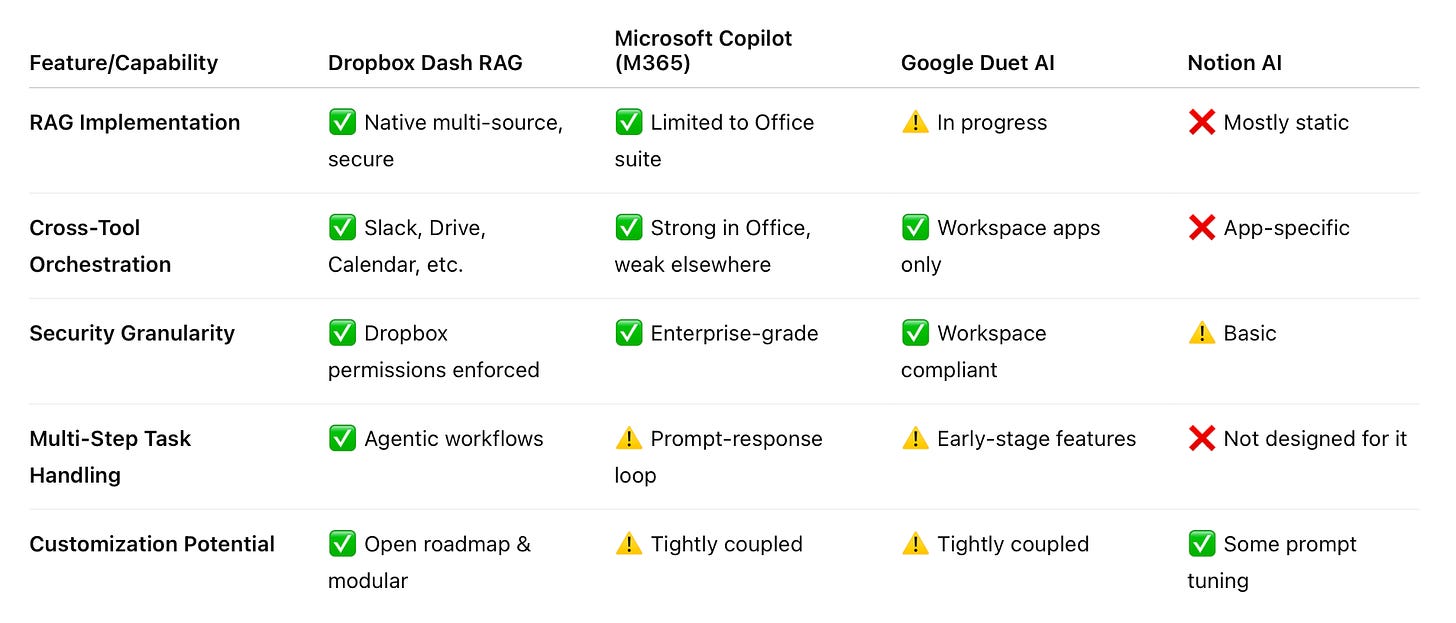As AI assistants evolve from novelty tools to integral components of business productivity, Dropbox’s Dash RAG (Retrieval-Augmented Generation) stands out not just for what it does—but how it does it. The recent announcement, “Building Dash RAG: Multi-Step AI Agents for Business Users,” is a strategic evolution in how generative AI can reshape daily workflows for knowledge workers.
Having led teams across enterprise platforms and developer ecosystems, I see Dash RAG not as just another chatbot—but as a hybrid execution engine built on context-aware retrieval, tightly coupled with AI-driven generation. It's a compelling sign of what the future of work can—and should—look like.
Please help us make Tech Scoop better by filling out a quick reader survey.
Why Dash RAG Matters
Traditional LLM-based assistants are powerful, but often fall short in real enterprise use. They hallucinate, misinterpret context, or rely on stale knowledge. Dropbox's RAG approach addresses this by augmenting language models with real-time, user-specific data retrieval.
That shift changes the game.
Where legacy assistants offer generic answers, Dash RAG grounds its outputs in your documents, emails, calendars, and tools. It's not just responding—it’s working for you.
I see this as an important architectural transition:
From chat to agent
From prompt to workflow
From static AI to context-driven orchestration
The Anatomy of Dash RAG: A Modular Multi-Step Agent
What impressed me most is the agentic design that mirrors how a human assistant might operate:
Intent Recognition. Natural prompts like “Prepare a follow-up email for yesterday’s design sync” are parsed for both task and context.
Intelligent Retrieval. Context is gathered from your actual data—Docs, Gmail, Slack, etc.—using real-time semantic search.
Data Curation. Rather than just dumping everything into the prompt, Dash RAG curates and structures the inputs.
Grounded Generation. Using LLMs, it generates output *based on* retrieved knowledge, not hallucinated summaries.
Interactive Refinement. Users can iterate, modify, or trigger follow-up steps—blurring the lines between tool and teammate.
Real-World Wins: Beyond Productivity, Toward Performance
Dash RAG isn’t just about automating grunt work. It’s a knowledge accelerator* Some compelling use cases:
Email Drafting. Synthesizes conversations across channels to draft timely, context-aware emails.
Meeting Summaries. Uses transcripts and referenced docs to create follow-up actions and highlights.
Project Planning. Pulls calendar events, documents, and to-dos into unified, actionable plans.
These aren't gimmicks—they’re time-saving, cost-reducing workflows.
What SaaS Leaders & Developers Can Steal from Dash RAG
If you're leading a SaaS product or managing AI development teams, there are five key practices you should borrow from Dropbox’s approach:
Design AI as a Workflow Partner, Not a Feature. Dropbox didn’t just bolt an LLM onto their UI. They designed agents that execute multi-step workflows, just like a digital teammate. Shift from task-based UX to goal-based UX.
🔁 What to steal: Think in agent flows, not in autocomplete.
Use Retrieval as a Trust Anchor. Dash RAG uses Retrieval-Augmented Generation to ground every response in the user’s own data. This eliminates hallucination and builds trust.
🔁 What to steal: Integrate contextual retrieval from user data before LLM prompting. Don’t let your model guess what it can look up.
Prioritize Secure, Permissioned Architecture. Dropbox ensured that Dash RAG respects existing file permissions and access controls—critical for B2B credibility.
🔁 What to steal: Build AI pipelines with fine-grained access control from day one. AI is only useful if it’s *safe*.
Expose Iteration Loops to the User. Instead of a “take it or leave it” answer, Dash RAG encourages iterative refinement. That’s powerful for user control and adoption.
🔁 What to steal: Make AI outputs editable, traceable, and revisable. Feedback loops create trust and personalization.
Go Beyond the Walled Garden. Dash RAG doesn’t just work within Dropbox—it pulls from Slack, Drive, Calendar, and more. That’s key for real productivity.
🔁 What to steal: Build integrations. Your AI should live where users work—not where you wish they worked.
How Dash RAG Compares to Other AI Assistants
Dropbox has a narrow but potent advantage: platform-agnostic, agentic workflows with built-in trust and data fidelity.
Security: Still a Competitive Differentiator
Dropbox built Dash RAG with security at the forefront. It honors user permissions across every document and request. In a world of shadow AI tools and unsecured plugins, this matters.
The takeaway for SaaS companies? If your AI touches enterprise data, your AI *is* an enterprise risk surface. Plan accordingly.
What Needs to Improve
While promising, Dash RAG is still maturing. Here’s where it could go further:
Workflow Builder: Let users create or edit agent flows visually.
Multimodal Input Support: Integrate voice, video, and whiteboards for richer task contexts.
Faster Response Latency: As with most RAG agents, speed is an issue under load.
Enterprise Tool Expansion: Plug into CRMs, analytics tools, and engineering platforms.
Looking Ahead: From Assistant to Operating System
Dropbox is laying the foundation for something bigger than a tool: a productivity operating system driven by AI agents.
It’s a challenge to get the architectural primitives and user experience right. Dropbox is close. With openness, extensibility, and focus on trust, Dash RAG could become the agent layer for the enterprise cloud stack—the connective tissue across your apps, files, and workflows.
Final Thoughts
SaaS is entering the agentic era. Dash RAG is a preview of what’s next: AI not as a sidekick, but as a partner.
If you're building for this new world, learn from Dropbox:
Solve workflows, not prompts.
Ground outputs in truth.
Respect user trust at every step.
We don’t need more AI tools. We need smarter, safer, more useful ones. Dash RAG sets a new bar—and we should all take note.
PARTNER WITH US
We’re now welcoming a limited number of sponsors who align with our SaaS-focused audience.
👉 Interested? Fill out this quick form to start the conversation.




